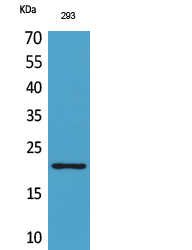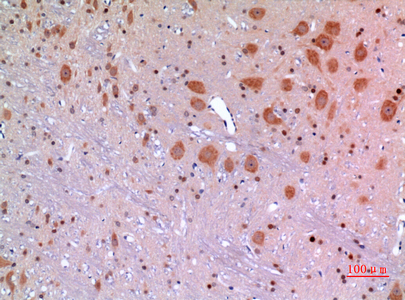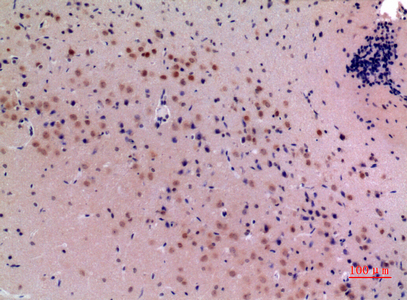ARP Polyclonal Antibody
- 产品详情
- 实验流程
- 背景知识
Application
| WB, IHC-P |
|---|---|
| Primary Accession | P55145 |
| Reactivity | Human, Mouse, Rat |
| Host | Rabbit |
| Clonality | Polyclonal |
| Calculated MW | 20700 Da |
| Gene ID | 7873 |
|---|---|
| Other Names | MANF; ARMET; ARP; Mesencephalic astrocyte-derived neurotrophic factor; Arginine-rich protein; Protein ARMET |
| Dilution | WB~~Western Blot: 1/500 - 1/2000. IHC-p: 1/100-1/300. ELISA: 1/20000. Not yet tested in other applications. IHC-P~~Western Blot: 1/500 - 1/2000. IHC-p: 1/100-1/300. ELISA: 1/20000. Not yet tested in other applications. |
| Format | Liquid in PBS containing 50% glycerol, 0.5% BSA and 0.09% (W/V) sodium azide. |
| Storage Conditions | -20℃ |
| Name | MANF (HGNC:15461) |
|---|---|
| Synonyms | ARMET, ARP |
| Function | Selectively promotes the survival of dopaminergic neurons of the ventral mid-brain (PubMed:12794311). Modulates GABAergic transmission to the dopaminergic neurons of the substantia nigra (By similarity). Enhances spontaneous, as well as evoked, GABAergic inhibitory postsynaptic currents in dopaminergic neurons (By similarity). Inhibits cell proliferation and endoplasmic reticulum (ER) stress-induced cell death (PubMed:18561914, PubMed:22637475, PubMed:29497057, PubMed:36739529). Retained in the ER/sarcoplasmic reticulum (SR) through association with the endoplasmic reticulum chaperone protein HSPA5 under normal conditions (PubMed:22637475). Stabilizes HSPA5/BiP in its substrate-bound ADP state, which facilitates HSPA5/BiP incorporation into chaperone-client complexes during endoplasmic reticulum stress, its interaction with HSPA5/BiP inhibits ATP binding to HSPA5/BiP and subsequent nucleotide exchange (By similarity). As a result acts as a repressor of the unfolded protein response (UPR) pathway (By similarity). Up-regulated and secreted by the ER/SR in response to ER stress and hypoxia (PubMed:22637475). Following secretion by the ER/SR, directly binds to 3-O-sulfogalactosylceramide, a lipid sulfatide in the outer cell membrane of target cells (PubMed:29497057). Sulfatide binding promotes its cellular uptake by endocytosis, and is required for its role in alleviating ER stress and cell toxicity under hypoxic and ER stress conditions (PubMed:29497057). Essential for embryonic lung development (By similarity). Required for the correct postnatal temporal and structural development of splenic white pulp (By similarity). Required for the repair-associated myeloid response in skeletal muscle, acts as a regulator of phenotypic transition towards prorepair macrophages in response to muscle injury and as a result limits excessive proinflammatory signaling (By similarity). Represses RELA expression and therefore NF-kB signaling in the myocardium, as a result limits macrophage infiltration of injured tissue and M1 macrophage differentiation in response to myocardial injury (By similarity). Required for endochondral ossification in long bones and the skull during postnatal development (By similarity). |
| Cellular Location | Secreted. Endoplasmic reticulum lumen. Sarcoplasmic reticulum lumen. Note=Retained in the endoplasmic reticulum (ER), and sarcoplasmic reticulum (SR) under normal conditions (PubMed:22637475). Up-regulated and secreted by the ER/SR in response to ER stress and hypoxia (PubMed:22637475, PubMed:29497057) |
For Research Use Only. Not For Use In Diagnostic Procedures.
Provided below are standard protocols that you may find useful for product applications.
BACKGROUND
Selectively promotes the survival of dopaminergic neurons of the ventral mid-brain (PubMed:12794311). Modulates GABAergic transmission to the dopaminergic neurons of the substantia nigra (By similarity). Enhances spontaneous, as well as evoked, GABAergic inhibitory postsynaptic currents in dopaminergic neurons (By similarity). Inhibits cell proliferation and endoplasmic reticulum (ER) stress-induced cell death (PubMed:18561914, PubMed:22637475, PubMed:29497057). Retained in the ER/sarcoplasmic reticulum (SR) through association with the endoplasmic reticulum chaperone protein HSPA5 under normal conditions (PubMed:22637475). Up-regulated and secreted by the ER/SR in response to ER stress and hypoxia (PubMed:22637475). Following secretion by the ER/SR, directly binds to 3-O- sulfogalactosylceramide, a lipid sulfatide in the outer cell membrane of target cells (PubMed:29497057). Sulfatide binding promotes its cellular uptake by endocytosis, and is required for its role in alleviating ER stress and cell toxicity under hypoxic and ER stress conditions (PubMed:29497057).
终于等到您。ABCEPTA(百远生物)抗体产品。
点击下方“我要评价 ”按钮提交您的反馈信息,您的反馈和评价是我们最宝贵的财富之一,
我们将在1-3个工作日内处理您的反馈信息。
如有疑问,联系:0512-88856768 tech-china@abcepta.com.























 癌症的基本特征包括细胞增殖、血管生成、迁移、凋亡逃避机制和细胞永生等。找到癌症发生过程中这些通路的关键标记物和对应的抗体用于检测至关重要。
癌症的基本特征包括细胞增殖、血管生成、迁移、凋亡逃避机制和细胞永生等。找到癌症发生过程中这些通路的关键标记物和对应的抗体用于检测至关重要。 为您推荐一个泛素化位点预测神器——泛素化分析工具,可以为您的蛋白的泛素化位点作出预测和评分。
为您推荐一个泛素化位点预测神器——泛素化分析工具,可以为您的蛋白的泛素化位点作出预测和评分。 细胞自噬受体图形绘图工具为你的蛋白的细胞受体结合位点作出预测和评分,识别结合到自噬通路中的蛋白是非常重要的,便于让我们理解自噬在正常生理、病理过程中的作用,如发育、细胞分化、神经退化性疾病、压力条件下、感染和癌症。
细胞自噬受体图形绘图工具为你的蛋白的细胞受体结合位点作出预测和评分,识别结合到自噬通路中的蛋白是非常重要的,便于让我们理解自噬在正常生理、病理过程中的作用,如发育、细胞分化、神经退化性疾病、压力条件下、感染和癌症。

.jpg)
.jpg)

.jpg)






